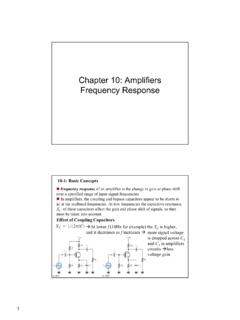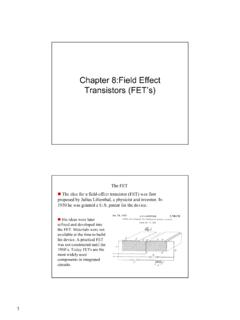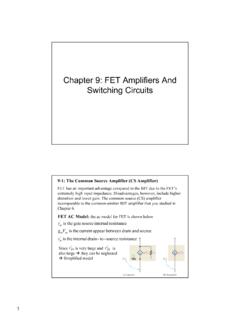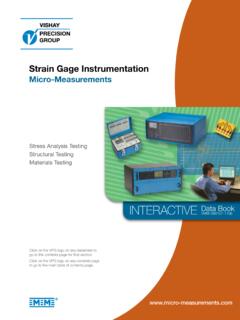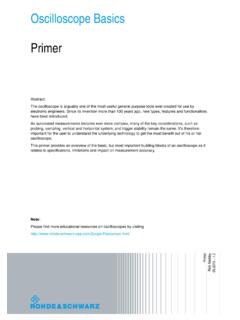Transcription of Measurement and Instrumentation Principles
1 Measurement andInstrumentation PrinciplesTo Jane, Nicola and JuliaMeasurement andInstrumentationPrinciplesAlan S. MorrisOXFORD AUCKLAND BOSTONJOHANNESBURG MELBOURNENEW DELHIB utterworth-HeinemannLinacre House, Jordan Hill, Oxford OX2 8DP225 Wildwood Avenue, Woburn, MA 01801-2041A division of Reed Educational and Professional Publishing LtdA member of the Reed Elsevier plc groupFirst published 2001 Alan S. Morris 2001 All rights reserved. No part of this publicationmay be reproduced in any material form (includingphotocopying or storing in any medium by electronicmeans and whether or not transiently or incidentallyto some other use of this publication) without thewritten permission of the copyright holder exceptin accordance with the provisions of the Copyright,Designs and Patents Act 1988 or under the terms of alicence issued by the Copyright Licensing Agency Ltd,90 Tottenham Court Road, London, England W1P for the copyright holder s written permissionto reproduce any part of this publication should be addressedto the publishersBritish Library Cataloguing in Publication DataA catalogue record for this book is available from the British LibraryISBN 0 7506 5081 8 Typeset in 10/12pt Times Roman by Laser Words, Madras, IndiaPrinted and bound in Great BritainContentsPrefacexviiAcknowledgemen tsxxPart 1.
2 Principles of Measurement11 INTRODUCTION TO system of a Measurement appropriate measuring instruments92 INSTRUMENT TYPES AND of instrument and passive and deflection-type and digital instruments and instruments with asignal and non-smart characteristics of and inaccuracy ( Measurement uncertainty) or of to characteristics of order order order for questions303 ERRORS DURING THE Measurement of systematic disturbance due to due to environmental in instrument of systematic instrument of opposing correction of output of systematic analysis of measurements subject torandom data analysis techniques of Measurement system effect of systematic and random of errors from separate measurementsystem error when combining multiple questions60 References and further reading634 CALIBRATION OF MEASURING SENSORS of of calibration chain and records71 References and further reading725 Measurement NOISE AND SIGNAL of Measurement (electrostatic)
3 Due to multiple in the form of voltage for reducing Measurement and design of signal to signal signal analogue analogue analogue signal processing (zero drift) follower (pre-amplifier) signal and hold (D/A) digital signal processing operations101 References and further reading1016 ELECTRICAL INDICATING AND TEST conversion digital digital integration digital conversion digital high-frequency analogue of meter outputs for ray ray sensitivity position storage oscilloscopes118 References and further reading1187 VARIABLE CONVERSION , bridge (Wheatstone bridge) bridge ammeter of the digital voltmeter to measure for resistor codes for capacitor ray Wien Y questions147 References and further reading150 Contentsix8 SIGNAL as varying loop using an of fibre wireless telemetry (radio wireless transmission) transmission protocols163 References and further reading1649 DIGITAL COMPUTATION AND INTELLIGENT of digital of a considerations in adding computers tomeasurement with intelligent in intelligent trends in intelligent questions185 References and further reading18610 Instrumentation /COMPUTER communication data area networks (LANs)
4 And bus protocols for very large development of networks199 References and further reading199xContents11 DISPLAY, RECORDING AND PRESENTATION OFMEASUREMENT of Measurement output monitor of Measurement chart recorders (recording oscilloscopes) chart tape of data presentation of questions222 References and further reading22312 Measurement RELIABILITY AND SAFETY of of reliability in complex Measurement system to safety of safety of a safety questions241 References and further reading242 Part 2: Measurement Sensors and Instruments24513 SENSOR and resistive sensors (air path) sensors (fibre-optic) of travel of ultrasound of ultrasound between wavelength, frequency anddirectionality of ultrasound of ultrasound as a range of ultrasound in tracking 3D object of noise in ultrasonic Measurement Doppler shift in ultrasound Ultrasonic and further reading27014 TEMPERATURE of temperature effect sensors (thermocouples) reference junction continuous resistance thermometers (resistance temperaturedevices) (thermal imaging)
5 Expansion temperature of state of temperature-measuring between temperature questions302 References and further reading30315 PRESSURE pressure pressure Measurement devices for low Measurement (greater than 7000 bar) pressure of pressure sensors31616 FLOW flow mass flow Measurement of volume flow rate and flow pressure (obstruction-type) area flowmeters (Rotameters) displacement types of flowmeter for measuring volumeflow between flowmeters for particular applications338 References and further reading33917 LEVEL devices (hydrostatic systems) level (microwave) level elements/carbon resistor level level-measuring between different level sensors351 References and further reading35118 MASS, FORCE AND TORQUE (weight) load cell (electronic balance) load load (weighing) of wire forces in shaft of induced torque measurement36419 TRANSLATIONAL MOTION resistive variable differential transformer (LVDT) capacitance inductance methods of measuring small of large displacements (range sensors)
6 Proximity Selection of translational Measurement of displacement of the output of an to rotational of of ROTATIONAL MOTION and helical differential shaft shaft induction rotary Choice between rotational displacement rate of angular displacement of the output from an between rotational velocity of rotational acceleration417 References and further reading41821 SUMMARY OF OTHER and blocks (slip gauges) and length and depth and tube body moisture Measurement techniques for moisture glass methods of pH sensing and (calorimetric) tape electrolyte electrochemical electrochemical cells (zirconia sensor) gate (metal oxide) Mass Gas chromatography443 References and further reading444 APPENDIX 1 Imperial metric SI conversion tables445 APPENDIX 2Th evenin s theorem452 APPENDIX 3 Thermocouple tables458 APPENDIX 4 Solutions to self-test questions464 INDEX469 PrefaceThe foundations of this book lie in the highly successful textPrinciples of Measurementand Instrumentationby the same author.
7 The first edition of this was published in 1988,and a second, revised and extended edition appeared in 1993. Since that time, a numberof new developments have occurred in the field of Measurement . In particular, therehave been significant advances in smart sensors, intelligent instruments, microsensors,digital signal processing, digital recorders, digital fieldbuses and new methods of signaltransmission. The rapid growth of digital components within Measurement systems hasalso created a need to establish procedures for measuring and improving the reliabilityof the software that is used within such components. Formal standards governing instru-ment calibration procedures and Measurement system performance have also extendedbeyond the traditional area of quality assurance systems (BS 5781, BS 5750 and morerecently ISO 9000) into new areas such as environmental protection systems (BS 7750and ISO 14000).
8 Thus, an up-to-date book incorporating all of the latest developmentsin Measurement is strongly needed. With so much new material to include, the oppor-tunity has been taken to substantially revise the order and content of material presentedpreviously inPrinciples of Measurement and Instrumentation , and several new chaptershave been written to cover the many new developments in Measurement and instru-mentation that have occurred over the past few years. To emphasize the substantialrevision that has taken place, a decision has been made to publish the book under anew title rather than as a third edition of the previous book. Hence, Measurement andInstrumentation Principleshas been overall aim of the book is to present the topics of sensors and Instrumentation ,and their use within Measurement systems, as an integrated and coherent systems, and the instruments and sensors used within them, are ofimmense importance in a wide variety of domestic and industrial activities.
9 The growthin the sophistication of instruments used in industry has been particularly significant asadvanced automation schemes have been developed. Similar developments have alsobeen evident in military and medical , the crucial part that Measurement plays in all of these systems tendsto get overlooked, and Measurement is therefore rarely given the importance that itdeserves. For example, much effort goes into designing sophisticated automatic controlsystems, but little regard is given to the accuracy and quality of the raw measurementdata that such systems use as their inputs. This disregard of Measurement systemquality and performance means that such control systems will never achieve their fullxviiiPrefacepotential, as it is very difficult to increase their performance beyond the quality of theraw Measurement data on which they , the Principles of good Measurement and Instrumentation practice should betaught throughout the duration of engineering courses, starting at an elementary leveland moving on to more advanced topics as the course progresses.
10 With this in mind,the material contained in this book is designed both to support introductory courses inmeasurement and Instrumentation , and also to provide in-depth coverage of advancedtopics for higher-level courses. In addition, besides its role as a student course text, itis also anticipated that the book will be useful to practising engineers, both to updatetheir knowledge of the latest developments in Measurement theory and practice, andalso to serve as a guide to the typical characteristics and capabilities of the range ofsensors and instruments that are currently in text is divided into two parts. The Principles and theory of Measurement arecovered first in Part 1 and then the ranges of instruments and sensors that are availablefor measuring various physical quantities are covered in Part 2.




